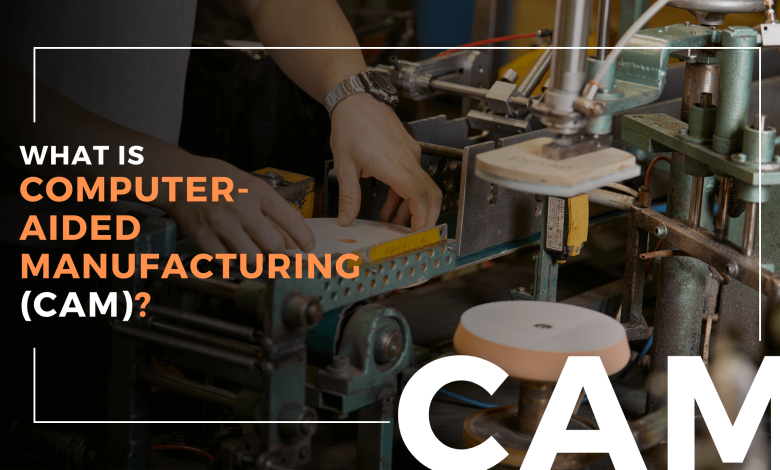What is Computer-Aided Manufacturing (CAM)?

Over the past few years, we have seen the world moving towards better technology for our everyday activities. Technology has opened new doors for everything that we need. The same effects can be seen in the manufacturing units. The industries today are using such high-end technology to create products with accuracy and precision. This process is widely popular as CAM amongst the manufacturing units.
Computer-Aided Manufacturing (CAM) is the procedure of using computing technology and automated software to produce goods and services. This software uses high-tech features to create products with better quality, less rework, and high efficiency. The system enables the manufacturer to produce goods more smartly while having total control over the entire manufacturing process.
CAM helps the manufacturers in the entire manufacturing process starting from planning of the product, to designing, managing, logistics support, and ultimately execution. CAM lays the foundation for Computer-Aided designs (CAD). It aims to improve the traditional manufacturing processes by increasing the efficiency of the system. It targets to make manufacturing smarter with less wastage of resources. This technology has resulted in high accuracy and efficiency at a reduced manufacturing cost.
CAM automated manufacturing processes
CAM has benefited various industries in automating their manufacturing processes using Computer Numeric Control machines (CNC). The following processes were automated using CAM:
- Milling of the workpiece and removing extra pieces more accurately
- Using CNC to create the right order of procedure and moving excess materials in the turning process
- Achieving accuracy in laserjet and plasma cutting processes
- Controlling high-temperature electric sparks while cutting workpieces
Benefits of having a CAM system
CAM has been a turning point for manufacturing industries to create smarter and efficient production systems. Here’s why you must invest in a CAM system:
- Accuracy and speed: CAM is a reliable system to create accurate designs at a faster pace as compared to the traditional stems. Their automated features can produce the same design multiple times without missing a beat. Very prototype card yCAM has a unique level of accuracy.
- Low wastage: CAM is an automated system that aims at producing goods at a lower level wastage. The designs are created using technology and at a low level of required. This increases the productivity of the firm. It also adds value to the industry as a huge amount of products can be created using a given amount of raw materials.
- Educed manpower requirement: CAM reduces the number of laborers required to manufacture the product. The automated system takes care of all planning and designing. This reduces the number of artists required to design the product. The firm only needs labor to execute and manage the manufacturing process. This reduces the overall labor cost.
- Overall control over the manufacturing process: It was difficult for the manufacturers to keep a track of all manufacturing processes using the traditional system. Using CAM, every process can be tracked while the manufacturers focus on the important aspects. It gives them overall control over the process.
Disadvantages of the CAM system
Despite the multiple benefits of CAM, every coin has two sides and so does CAM. CAM is an exceptional technology for all manufacturers, but it comes with certain disadvantages such as:
- Costly: The biggest limitation of a CRM system is the cost incurred installing and maintaining the system. The software and hardware parts are expensive as compared to the traditional manual arts. It further requires constant Maintenance which often increases the cost on the firm’s part.
- Skilled labor to manage the system: Since CAM uses high-end technology, not every member of the manufacturing team can handle the system well. It requires skilled personnel to run the CAM system. It is also not very easy to learn for newcomers and often needs intensive training before the system can be implemented.
- Nonrecyclable waste: While CAM ensures minimal wastage of resources during the production process, there are some leftovers when the production is over Suchleftovers cannot be recycled back to be used in the upcoming cycles. These leftovers come to the attention of the manufacturers when it is too late and thus increase non-recyclable waste.
- Technological glitch: Since CAM uses technology to manufacture products, failure in technology or glitches in the computer system can hamper the process.
Relationship between CAD and CAM
Computer-Aided Design (CAD) and CAM are often seen interchangeably. However, there are differences between the two systems. CAD is used to plan and design the product including all modifications required during the pre-designing stage. CAM is the process undertaken after CAD. The designs created using the CAD system are further converted into the language acceptable by the machine. G nodes and M nodes are used to convert these designs for manufacturing. The CNC machinery further sees these designs to execute the manufacturing process.
Final Words
CAM has revolutionized various industries including aerospace, automotive pharmaceutical, hardware manufacturing, etc. It is an important investment in the current competitive market to gain an advantage over the new entrants. Industries using CAM have various benefits to give them an upper hand in the market. If you wish to upgrade your manufacturing princess by CAM, find the experts now!





